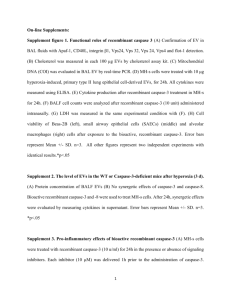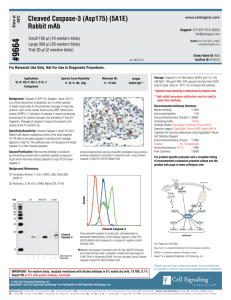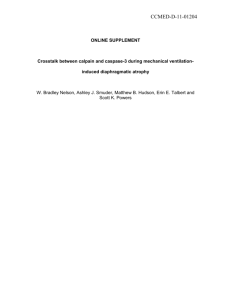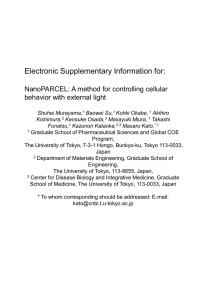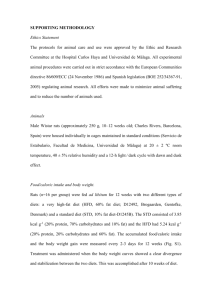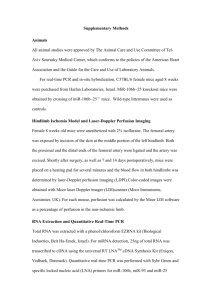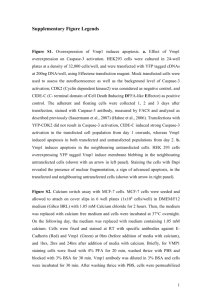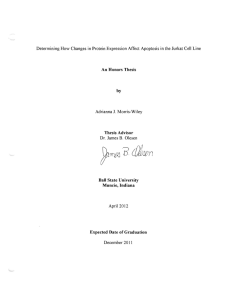Antiproliferative effect of isolated isoquinoline alkaloid
advertisement
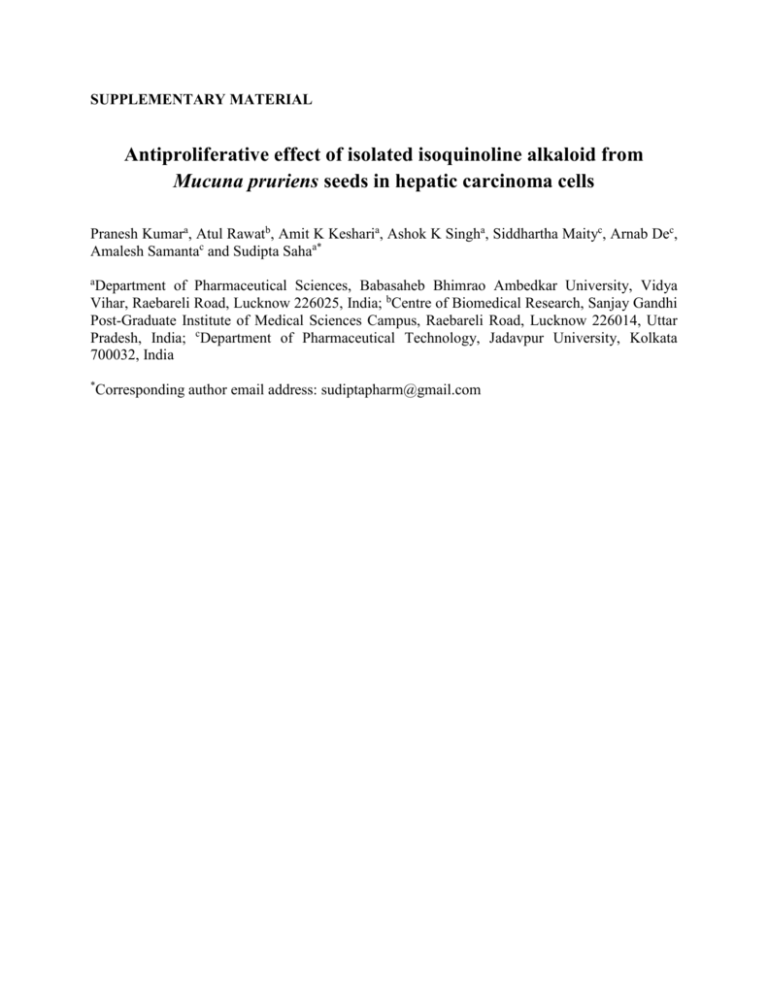
SUPPLEMENTARY MATERIAL Antiproliferative effect of isolated isoquinoline alkaloid from Mucuna pruriens seeds in hepatic carcinoma cells Pranesh Kumara, Atul Rawatb, Amit K Kesharia, Ashok K Singha, Siddhartha Maityc, Arnab Dec, Amalesh Samantac and Sudipta Sahaa* a Department of Pharmaceutical Sciences, Babasaheb Bhimrao Ambedkar University, Vidya Vihar, Raebareli Road, Lucknow 226025, India; bCentre of Biomedical Research, Sanjay Gandhi Post-Graduate Institute of Medical Sciences Campus, Raebareli Road, Lucknow 226014, Uttar Pradesh, India; cDepartment of Pharmaceutical Technology, Jadavpur University, Kolkata 700032, India * Corresponding author email address: sudiptapharm@gmail.com The present study was undertaken to investigate the antiproliferative action of isolated M1 (6,7Dimethoxy-1,2,3,4-tetrahydroisoquinoline-3-carboxylic acid) from Mucuna pruriens seeds using human hepatic carcinoma cell line (Huh-7 cells). Initially, docking studies was performed to find out the binding affinities of M1 to caspase-3 and 8 enzymes. Later, cytotoxic action of M1 was measured by cell growth inhibition (MTT), followed by caspase-3 & 8 enzymes assay colorimetrically. Our results collectively suggested that M1 had strong binding affinity to caspase-8 in molecular modeling. M1 possessed antiproliferative activity on Huh-7 cells (EC50 = 13.97 µM) and also inhibited the action of caspase-8 enzyme, signified process of apoptosis. M1 was active against Huh-7 cells that may be useful for future hepatic cancer treatment. Keywords: Isoquinoline alkaloid; Molecular docking; Huh-7 cells; Caspase 3 & 8 Experimental General Experimental Procedures UV spectra were recorded using Aquamate 8000 UV/VIS spectrophotometer (ThermoFisher Scientific, MA, USA). IR spectra were obtained on a IRTracer-100 FTIR spectrophotometer (Shimatzu, Koyto, Japan). NMR spectra were measured on Bruker 400 MHz NMR spectrometer (1H 400 MHz, 13C 100 MHz) NMR spectrometers (Rheinstetten, Germany). Direct-infusion mass spectroscopy (MS) data were acquired using a hybrid triple quadrupole linear ion trap MS (QTRAP MS) equipped with an electrospray ionization (ESI) source (2000 QTRAP, Applied Biosystems, Foster City, CA, USA). Chemicals Dulbecco’s Modified Eagle Medium (DMEM), caspase-3 and caspase-8 colorimetric assay kits were purchased from Invitrogen Bioservices, India. Petroleum ether, ethyl acetate and methanol were purchased from Merck (Merck, India). Dimethyl sulfoxide (DMSO, ACS grade), trypsin ethylenediaminetetraacetic acid (trypsin-EDTA), Tris-HCl buffer, EDTA, sodium dodecyl sulfate and protenase-K were obtained from S.D. Fine Chemicals, India. Huh-7 and RAW 264.7 cell lines were purchased from ATCC (Manassas, VA, USA). Water was purified using a Milli-Q water purification system (Millipore, Bedford, MA, USA). All other reagents were purchased from Sigma Aldrich, India. Plant Materials, Extraction and Isolation Seeds of MP were collected from eastern part of Uttar Pradesh, India and authenticated by Department of Applied Plant Science, Babasaheb Bhimrao Ambedkar University, Lucknow. A voucher specimen of this sample was deposited in the Department for future use (42/DAPS/BBAU/2014). The air dried seeds were crushed and powered with were crushed by using a mixer grinder (Bajaj Appliances Pvt. Ltd., India). About 750 g of powder was defatted with petroleum ether (60-80°C) and further extracted with methanol (Tadesse et al., 2012). The pooled methanol extract was evaporated in vacuo using rotary evaporator (RV10, IKA, Germany) to give a residue of (21 g). Then, this extract was further chromatographed with neutral alumina column chromatography with gradient elution of petroleum ether (60-80°C) and ethyl acetate in a ratio of 90: 10, 50:10 and 20:10. The last fraction gave one white power which was recrystalised with ethyl acetate (white solid, yield 105 mg, M1, Figure 1A). Docking studies Docking studies of M1 was performed with antiproliferative molecular targets namely caspase-3 (PDB: 1QXE) and caspase-8 (PDB: 1IBC) by using Autodock Vina. Before the docking study, we have identified the active site domain with the help of DogP acitive Site recognizer. Grid box was set according to best configuration of active site of amino acid sequence. Binding affinities (kcal/mol) and count of probable hydrogen bonds were evaluated in this experiment. Antiproliferative activity using Huh-7 cells MTT [3-(4, 5-Dimethylthiazol-2-yl)-2,5-diphenyltetrazolium bromide, a tetrazole] viability assay was performed as described previously (Saha et al. 2010). Briefly, Huh-7 cells were seeded at 5.0×103 cells/well in 96-well plates. After 24 h, varying concentrations of MTX and M1 and (0.5 to 100 µM) (n=6) in media was added to each well and the samples were incubated in a humidified condition 5% CO2 at 37°C for 72 h. After that, MTT solution (1 mg/ml, 50 µl) was added to each well and incubated for another 4 h. Later, MTT and media were removed and 150 µl of DMSO was added. The absorbance was measured at 570 nm wavelength using Multiskan™ GO Microplate Spectrophotometer (ThermoFisher Scientific, MA, USA). Control and Blank sample was prepared using with and without cells containing media. The final organic solvent concentration was 0.3% (v/v). Cell survival (% of control) was calculated relative to untreated control cells. Data were analyzed by Graph Pad Prism 5 and represented as the mean ± S.D. Statistical differences were analyzed using paired T–test and P<0.05 represented the statistically significant data. Caspase 3 and 8 colorimetric assay Apoptotic activity in Huh-7 cells was determined using caspase-3 and caspase-8 colorimetric assay kits which published previously (Saha et al. 2012). Briefly, 2x104 cells/well were seeded in 96-well microplates and incubated for 24 h. Next day, varying concentrations of test compounds (0.5 to 10 µM) were added to each well and incubated for another 24 h at 37°C (n=4). After 24 h treatment, 100 ml of caspase-3 or caspase-8 reagents was added and the mixture further incubated for 2 h at room temperature. Relative luminescence (RLU) was recorded using Multiskan™ GO Microplate Spectrophotometer at 405 nm wavelength and results expressed as fold change vsersus control. Statistical differences were analyzed using one way-ANOVA and P<0.05 represented the statistically significant data. Statistical analysis Statistical analysis was carried out using GraphPad Prism 5.0 (San Diago, CA, USA). All results were expressed as mean ± standard deviation (SD). The data was analyzed by one-way ANOVA (analysis of variances) followed by Bonferroni multiple comparison test. References Saha S, Chan DSZ, Lee CY, Wong W, New LS, Chui WK, Yap CW, Chan ECY, Ho HK. 2012. Pyrrolidinediones reduce the toxicity of thiazolidinediones and modify their anti-diabetic and anticancer properties. Eur J Pharmacol. 697:13–23. Saha S, New LS, Ho HK, Chui WK, Chan ECY. 2010. Investigation of the role of the thiazolidinedione ring of troglitazone in inducing hepatotoxicity. Toxicol Lett. 192:141–149. Getahun T, Reneela P, Aman D. 2012. Isolation and characterization of natural products from Helinus mystachnus (Rhamnaceae). J Chem Pharm Res. 4:1756-1762. Figure S1. Docking images of M1 with caspase-3 (A) and caspase-8 (B) ligands. The mesh round circular showed the binding affinity of ligand with amino acids involved in binding poses. (A) (B) Figure S2. Viability of Huh-7 cells after treatment with M1 at varying concentrations for 72 h (n=6). MTT was used as detecting reagents. Viability is expressed as a percentage of vehicle-treated control and data was expressed as mean ± S.D. The calculated EC50 values for MTX and M1 were 2.99±0.11 and 13.97±0.13 µM, respectively. Statistically significant differences were observed between MTX and M1 (paired t-test, P<0.05) at and above 1.0 µM concentration. % cell viability 100 MTX M1 80 60 40 20 0 20 40 60 Concentration (M) 80 100 Figure S3. Characterizing the antiapoptotic properties of (A) and (C) MTX, (B) and (D) M1. Huh-7 cells were treated with at concentrations of 0.5, 1, 5, 10, µM for 24 h and subjected to caspase-3 and capase-8 activity determination (n=3). Activity was expressed as relative luminescence units (RLU) and compared against a DMSO-containing vehicle control. For, caspase-3, no statistical differences were demonstrated between control and test groups (one-way ANOVA, P<0.001) at all concentrations. For caspase-8, statistically significant differences were also observed between control and test groups at and above 1.0 µM (one-way ANOVA, P<0.001). CAS-3 M1 4000 2000 4000 2000 D D M 0. 5 SO 0 10 5 1 0. 5 0 6000 Concentration (M) Concentration (M) (A) (B) CAS-8 M1 2000 2000 0 M 10 5 1 0. 5 D D M SO 0 4000 Concentration (M) (C) Concentration (M) (D) 10 4000 6000 5 6000 8000 1 8000 10000 0. 5 10000 SO caspase-8 activity (RLU) CAS-8 MTX caspase-8 activity (RLU) 10 6000 8000 5 8000 10000 1 caspase-3 activity (RLU) 10000 M SO caspase-3 activity (RLU) CAS-3 MTX
